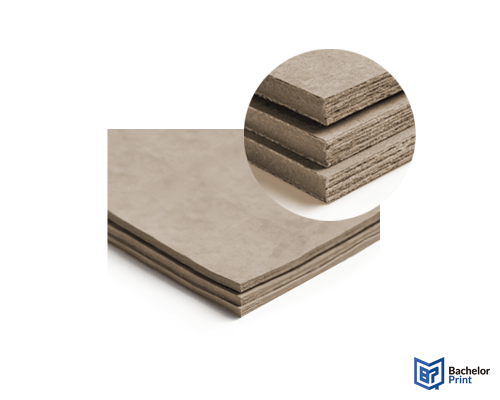
When it comes to book boards for professional or creative projects, the Davey board is considered the gold standard. Its strength, smooth surface, and archival quality make it indispensable in bookbinding, whether for premium hardcovers, archival collections, or custom-made albums. But what exactly sets it apart from other boards, and when should you choose it? In this article, we break down its properties, uses, and perks.
Definition: Davey board
A Davey board is a type of high-density, single-ply binder’s board used primarily in high-quality bookbinding. It was named after Charles Davey, who developed this durable, archival-quality material.
Unlike standard boards such as chipboard or greyboard, a Davey board is designed for strength, warp resistance, and longevity, making it the preferred choice for premium hardcovers and archival projects.
Hardcover with individual embossing
- Price calculator & 3D live preview
- Professional binding for thesis, dissertation, or books
- Print on demand with fast delivery right to your doorstep
Learn more!
Key properties
What makes a Davey board stand out from other book boards is its premium materials, impressive strength, and versatile surface, all designed for professional, long-lasting results.
- Acid-free and pH-neutral, ensuring archival quality for long-term use.
- Made from 100 % laminated, compressed fibers for a dense and durable core.
- Warp-resistant, maintaining its shape even under pressure or over time.
- Heavier and sturdier than standard chipboard, providing excellent support.
- Features a smooth surface ideal for wrapping with paper, cloth, or leather.
- Fully compatible with printing, foil stamping, and embossing for decorative finishes.

Davey board vs. chipboard
While both the Davey board and chipboard are commonly used in bookbinding, they differ significantly in quality, structure, and purpose:
Davey board
Chipboard
Structure
Single-ply, compressed fibers
Multi-ply, layered fibers
Quality
Archival, acid-free, long-lasting
Non-archival, often recycled
Density
Higher density, warp-resistant
Lower density, more flexible
Cost
More expensive
Budget-friendly
Best for
When to choose which?
➜ Davey board is ideal for high-end projects, like archival books or premium hardcovers.
➜ Chipboard works for budget-friendly or temporary projects, like simple packaging or prototypes.
Applications
Thanks to its durability and smooth surface, Davey board is used across a wide range of projects, from personal crafts to professional printing.
Bookbinding
It’s a staple in premium and archival bookbinding, providing strength and longevity for important works.
Creative projects
Its versatility also makes it ideal for DIY and creative design projects that require a sturdy base.
Commercial use
For businesses, Davey board offers a premium touch to packaging and presentation materials.
Benefits
Professionals and hobbyists alike prefer Davey board for its unmatched quality and reliability:
Pros
- Archival quality
➜ Acid-free and safe for the long-term storage of books, documents, and photos
- Durability and longevity
➜ Built to withstand frequent use and maintain its shape over time
- Professional appearance & premium feel
➜ Provides a sturdy, elegant base for high-end projects
Drawbacks
While Davey board offers many advantages, there are a few considerations to keep in mind:
Cons
- Higher cost
➜ More expensive than other basic book boards, which may not suit every budget
- Heavier weight
➜ Its density adds bulk, making projects heavier and slightly harder to handle
- Requires proper tools
➜ Cutting and shaping need heavy-duty equipment, which can be challenging for beginners
Printing services at BachelorPrint
- Individual solutions & personal support
- High print quality & fast production times
- Wide range of print products for every need
Learn more!
FAQs
It is a high-density, single-ply binder’s board often used for premium and archival bookbinding.
No. The Davey board is denser, single-ply, and of archival quality, while chipboard is multi-ply, lower in density, and usually less expensive.
Typically, between 0.059–0.098 inches (1.5–2.5 mm), depending on the intended use.
High-quality Davey board is often used for hardcovers, especially for premium or archival editions.